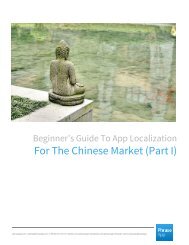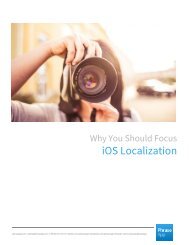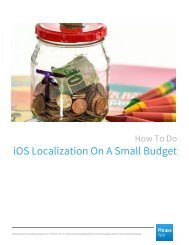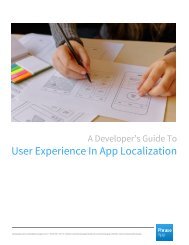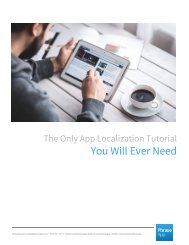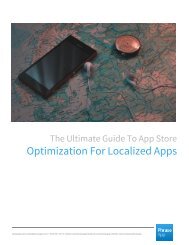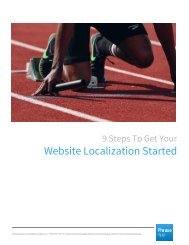21IOSLocalizationTrapsToAvoidIn2017
You also want an ePaper? Increase the reach of your titles
YUMPU automatically turns print PDFs into web optimized ePapers that Google loves.
21 iOS Localization Traps To Avoid In 2017<br />
1. Creating Your IOS App Without Thinking About<br />
Localization<br />
Correct iOS localization means creating a product that’s ready to go global right from the start.<br />
When you factor in international expansion from the beginning, rolling out multiple language<br />
versions will be much easier. This process is called internationalization. You are basically<br />
ensuring that your app is flexible enough to be tailored to any local market. You can stretch the<br />
design, change the colors and rewrite the code with ease.<br />
In other words, you should write your app so that it’s easy to translate, even though this will<br />
add some initial expense. Separate your text from your code and make sure your programmers<br />
use Unicode strings. This is the easiest way to develop an iOS app that can support any<br />
language and character. You may not know from the beginning which countries you’re going to<br />
target in the future. So, by leaving an open door to modifications, you’ll save time and money<br />
when you start the iOS localization processes.<br />
2. Not Translating Your App’s Name When Needed<br />
In most cases, it doesn’t matter how cool or interesting a name sounds in English when you<br />
take it global. If it isn’t appealing enough for foreigners, there’s no chance your app’s name will<br />
sell outside your country.<br />
Your app’s name should be easy to pronounce and recognize. Keeping it short and using clear<br />
descriptions of your app is essential. Especially when your products are sold in stores with over<br />
2 million other apps waiting in line! With so many options, customers simply won’t take the<br />
time to understand the meaning behind a strange sounding name. They’ll just download<br />
something else.<br />
Translating your app’s name is a wise solution, as long as you can keep your brand identity<br />
intact. Make sure that the translated meaning is close to your original name, as there’s nothing<br />
more frustrating than a misleading app name! The price for this kind of mistake during iOS<br />
localization is bad reviews. What do bad reviews lead to? Poor ranking in the App Store.<br />
phraseapp.com | sales@phraseapp.com | +49-40-357-187-76 | twitter.com/phraseapp | facebook.com/phraseapp | linkedin.com/company/phraseapp





